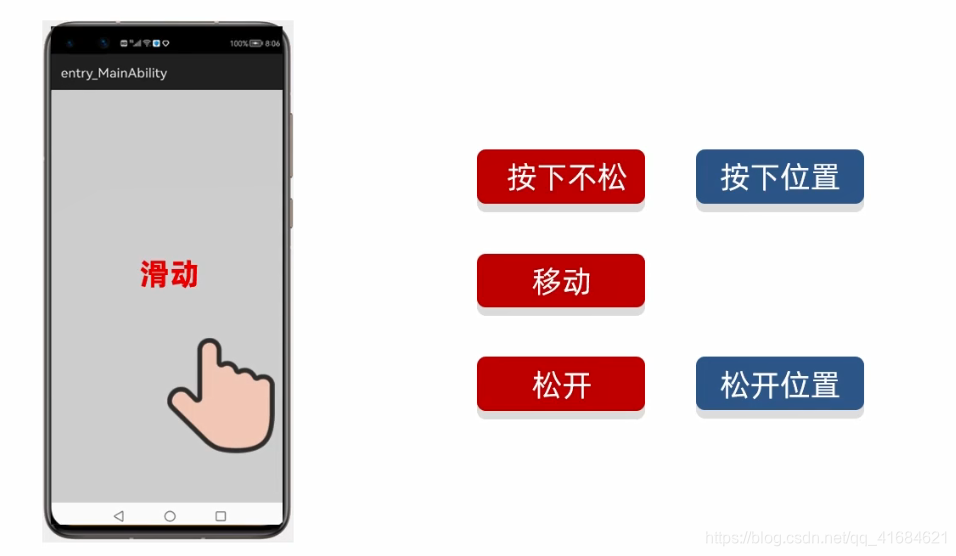文章目录
1. 滑动事件的三个动作
- 接口名:
TouchEventListener - 滑动事件里面分为三个动作:按下不松,移动,抬起。
PRIMARY_POINT_DOWN:按下不松。
POINT_MOVE:移动。
PRIMARY_POINT_UP:抬起。
- 方法返回值:
true 表示继续执行后面的动作。
false 表示不会继续执行后面的动作。
-
涉及到如下三个动作,根据用户按下位置和松下位置,就可以辨别用户是上、下、左、或右滑动。

-
如:可以辨别出用户是向右滑动(简称:右滑)

-
如:可以辨别出用户是向下滑动(简称:下滑)

2. 实现案例:按下、移动或松开都要修改文本的内容
- 因为要在整个屏幕上滑动,所以要给最外面的布局
DirectionalLayout设置滑动事件,加个id - 按下、移动或抬起都要修改文本的内容
- 新建项目:ListenerApplication4
- 代码实现
ability_main
- 采用默认生成的Text文本内容,在此基础上给
DirectionalLayout布局和Text组件分别加上id
<?xml version="1.0" encoding="utf-8"?>
<DirectionalLayout
ohos:id="$+id:dl"
xmlns:ohos="http://schemas.huawei.com/res/ohos"
ohos:height="match_parent"
ohos:width="match_parent"
ohos:alignment="center"
ohos:orientation="vertical">
<Text
ohos:id="$+id:text1"
ohos:height="match_content"
ohos:width="match_content"
ohos:background_element="$graphic:background_ability_main"
ohos:layout_alignment="horizontal_center"
ohos:text="$string:mainability_HelloWorld"
ohos:text_size="40vp"
/>
</DirectionalLayout>
MainAbilitySlice
- 采用当前类作为实现类接口的方式编写
package com.xdr630.listenerapplication.slice;
import com.xdr630.listenerapplication.ResourceTable;
import ohos.aafwk.ability.AbilitySlice;
import ohos.aafwk.content.Intent;
import ohos.agp.components.Component;
import ohos.agp.components.DirectionalLayout;
import ohos.agp.components.Text;
import ohos.multimodalinput.event.TouchEvent;
public class MainAbilitySlice extends AbilitySlice implements Component.TouchEventListener {
Text text1 = null;
@Override
public void onStart(Intent intent) {
super.onStart(intent);
super.setUIContent(ResourceTable.Layout_ability_main);
//1.先找到整个布局对象
DirectionalLayout dl = (DirectionalLayout) findComponentById(ResourceTable.Id_dl);
text1 = (Text) findComponentById(ResourceTable.Id_text1);
//2.给整个布局添加滑动事件
//当我们在整个布局滑动的时候,就会调用本类中的onTouchEvent方法
//在按下 移动、松开的过程,代码会不断去调用本类中的 onTouchEvent方法
dl.setTouchEventListener(this);
}
@Override
public void onActive() {
super.onActive();
}
@Override
public void onForeground(Intent intent) {
super.onForeground(intent);
}
@Override
public boolean onTouchEvent(Component component, TouchEvent touchEvent) {
//参数1:component表示滑动的组件(布局也是一种组件,所以也可以用component表示布局对象)
//实际上此时代表的就是DirectionalLayout布局对象,这个布局是铺满整个屏幕的
//参数2:touchEvent表示动作对象(按下、滑动、抬起)
//获取当前手指对屏幕进行操作(按下、滑动、抬起)
int action = touchEvent.getAction();
// 1:表示按下操作
// 2:表示松开操作
// 3. 表示滑动/移动操作
if (action == TouchEvent.PRIMARY_POINT_DOWN){
//只要写按下时需要运行的代码即可
text1.setText("按下");
}else if (action == TouchEvent.POINT_MOVE){
//移动或滑动
text1.setText("移动");
}else if (action == TouchEvent.PRIMARY_POINT_UP){
//松开或抬起
text1.setText("松开");
}
return true;
}
}
- 运行:

- 按下:

- 移动:

- 松开:

3. 按下、滑动、松开 参数说明


- 可以看到
1、2、3数字分别表示PRIMARY_POINT_DOWN(按下)、PRIMARY_POINT_UP(松开)、POINT_MOVE(移动),所以上面代码的参数也可以直接用数字代替,但为了更直观表达,建议使用参数,一目了然。 - 如:使用数字表示
if (action == 1){
//只要写按下时需要运行的代码即可
text1.setText("按下");
}else if (action == 3){
//移动或滑动
text1.setText("移动");
}else if (action == 2){
//松开或抬起
text1.setText("松开");
}
4. 验证 按下、 移动、松开的过程,代码会不断去调用本类中的 onTouchEvent方法
-
在上述代码的基础上,定义成员变量计数器
int count = 0

-
onTouchEvent方法被调用一次,就给加上一次

-
把
count放在每次操作的后面

-
当按下时,是第一次调用,
count应该为1

-
移动的时候随着鼠标不断移动,也就会不断地调用
onTouchEvent方法,count就会递增

-
当松开后,也会调用一次,
count在前面数值的基础上加1

-
所以,经过验证:
在 按下 、移动、松开的过程,代码会不断去调用本类中的 onTouchEvent方法。 -
【本文正在参与“有奖征文 | HarmonyOS征文大赛”活动】
https://marketing.csdn.net/p/ad3879b53f4b8b31db27382b5fc65bbc